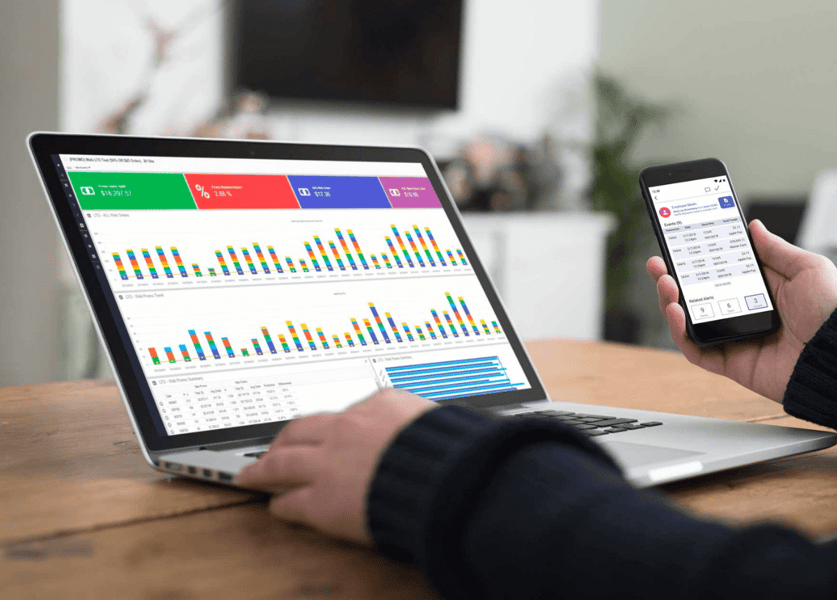7 Tips to Help Loss Prevention Professionals Implement a New Data Analytics Solution
General Derek Rodner
Derek Rodner

The world of retail Loss prevention is constantly evolving to better reduce shrink and detect areas of operational insufficiency. Although traditional LP strategies continue to hold their value, implementing a more high-tech data-driven solution provides a clearer view of how these phenomena occur and what actions need to be taken to prevent them. Experts have agreed that data analytics systems have greatly improved the LP departments that take the initiative to incorporate them into their organization, however when faced with the task of implementing this new method it can be easy to become intimidated by the complexity of organizing a new project like this.
Whether it be the time it takes to create a strategy or preparing your company for this new task every company faces different challenges when it comes to taking on a data analytics system. In this post, we hope to give you the tips needed so that implementing your new data system is quick, easy, and efficient.
Tip 1: Work with your IT Department
A great first step before implementing your data analytics solution is to meet with your IT team and fully explain the project, request a vendor demo, and offer to resolve any questions or concerns before the project gets underway. It is imperative that at an early stage of this new project you take an active role in its development and work with the IT department to give them a clear and precise action that they will be how this system will be developed and the time frame for when it will be completed.
Starting your implementation with a more well-thought-out plan and a strong relationship with your IT department Is a great first step to ensure your data system’s success.
Tip 2: Become a company priority
When presented with plans to implement a new analytics system your company may not yet be convinced that this system is worth its time and money, especially if you find yourself in a busy quarter. That is why you must convince them that a data analytics system is a high-value asset to the whole company and should be seen as an important task that they should complete with urgency and commitment. Focusing on return of investment and giving a short timeline of one year to accomplish this ROI (Return on Investment) will give your company the incentive needed to make your new analytics system a high priority.
Tip 3: Make your Goals Clear
Be sure to create a list of objectives that directly affect the return on the investment like eliminating unauthorized mark-downs, driving shrinkage down, identifying and resolving internal, reducing labor costs. When explaining your goals be sure to prioritize actions that require low labor hours over those that would take longer to do. When a new project is introduced, different parts can be delayed indefinitely getting the groundwork done first will help get the whole company prepared to engage in the implementing process.
Tip 4: Pick a Trusted Software Provider
A request for proposal (RFP) is a project announcement posted publicly by an organization indicating that bids for contractors to complete the project are sought. The RFP defines the project, for the company that issues it as well as the companies that respond to it. Even without a formal RFP, having your requirements is essential when looking at various solutions.
Evaluate each software vendor based on the robustness of the solution from a technical and business perspective and the software vendor’s ability to act as a trusted consultant. Make sure they understand your problems and design solutions to solve them. Software vendors must have a thorough understanding of their business and be knowledgeable and ready to answer business and technical questions, contribute new ideas and demonstrate the use of industry best practices.
Tip 5: Choose a Software Provider that Understands your Company’s Unique Needs
Evaluating the software providers can be an overwhelming task that can be confusing to those without a tech background, because of this you want to have the providers break down their service from a business standpoint as well as a technical one. Then see how their solution matches your business goals.
Your company will always wonder, how point of sale data analytics products can integrate, inventory, management, HR, and financial systems. Integration can be simple or complex depending on the vendor and solution. With publicly available and well-documented data dictionaries, integration guides, API (application programming interfaces) guides, and other resources available, you can easily educate yourself on the different kinds of solutions provided by each vendor. Some suppliers might already be integrated or pre-integrated together with your POS (Point of Sale) system. Responses to those varieties of queries will elevate one provider’s answer to the top of the list, making the choice all that easier.
Tip 6: Prioritize Training and Testing
After choosing the provider you think would work best with your company and implementing the solution, you should properly test the software and see how it is affecting business. All interfaces and functions should run with real-world scenarios and transaction data. Users should also double-check that business procedures are running smoothly across departments before the launch date, the system must be extensively tested.
A large part of implementing a data analytics system is making sure your employees understand how to use this new tool. Along with a large amount of time and effort training can be a massive strain on your employees who must now balance usual responsibilities with learning new software. Some suppliers additionally offer live classes, e-learning modules, or written manuals for user training and onboarding. Training may be included in the program purchase price or charged separately. Make sure to inquire about the level of support provided to new users by your vendor.
Tip 7: Constantly Monitor the Progress of the System
The implementation process isn’t over just because you have a new analytics system up and running. You should be constantly measuring the success of this new tool and keep up to date on how it’s affecting your employees and your company. Additionally, begin analyzing the system’s success immediately after it has gone live. Consider key performance indicators like costs, return on investment, decrease in human error, efficiency time savings, and customer engagement.
Implementing a new data analytics system can be an uphill battle filled with different obstacles and roadblocks. You may even find yourself in unique situations that require creative solutions depending on your company’s business model. However, if you follow these helpful tips the implementation process will be quicker and easier resulting in strong improvements for your company.
Recently, Agilence teamed up with Loss Prevention Magazine on a research report aimed at measuring the changing perceptions and value of Loss Prevention teams. Responses were collected from a hundred LP professionals at every level, operating in various industries. Download your free copy of the full report today to see the results.
Learn more about Loss Prevention & Asset Protection.
Related Articles

Remembering Gus Downing: A Loss Prevention Pioneer
It is with heavy hearts that we at Agilence mourn the passing of Gus Downing, a true luminary in the loss prevention (LP) and...
How can Leaders Really Measure the Impact of Loss Prevention Efforts?
In LPM’s recent survey, Evolving Perception of Value within Loss Prevention Departments, diverse opinions indicate the percep...
Agilence Becomes Newest Master Level Partner with Loss Prevention Foundation (LPF)
(Matthews, NC – February 14, 2020) The Loss Prevention Foundation (LPF) announced that Agilence, Inc. has advanced its partne...Subscribe to our blog
Receive free educational resources like exclusive reports, webinars, and industry thought leadership articles straight to your inbox.


